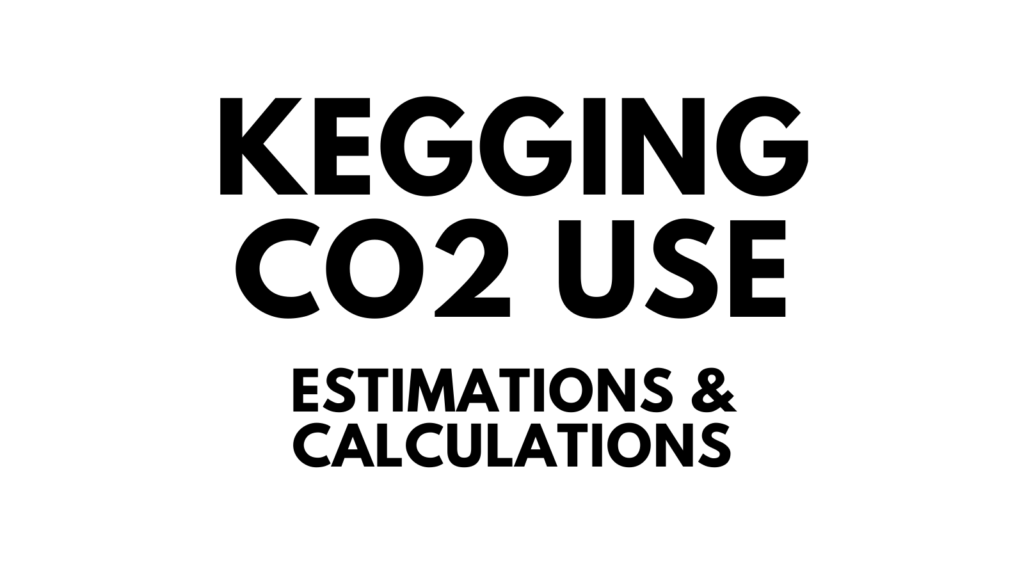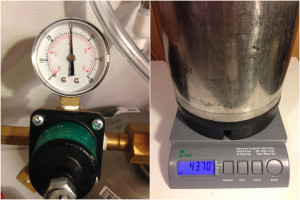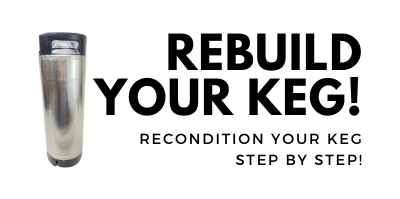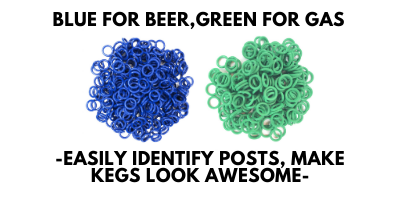
Kegging CO2 Use Estimations and Calculations
Updated: 6/6/2024
Estimating Kegerator CO2 Use
Have you ever wondered how much CO2 it takes to pressurize a keg or carbonate your beer?
This article contains affiliate links. We may make a small percentage if you use our links to make a purchase. You won’t pay more and you’ll be supporting Homebrew Finds and more content like this. Thank you for your support!
Related: Homebrew CO2 Tank Tips – New or Used & Tank Size
How Much CO2 Does It Take to Pressurize a Keg?
 Here is my 35 lb Digital Scale showing the total weight in grams of a 5 gallon ball lock keg that contains 10 PSI of CO2. The total weight comes out to 4,320 grams
Here is my 35 lb Digital Scale showing the total weight in grams of a 5 gallon ball lock keg that contains 10 PSI of CO2. The total weight comes out to 4,320 grams
Related: Rebuild Your Kegs
 This photo shows the weight of that same keg with 30 PSI of CO2. That means that 20 PSI of CO2, in a 5 gallon ball lock, weighs about 50 grams (1.76 ounces).
This photo shows the weight of that same keg with 30 PSI of CO2. That means that 20 PSI of CO2, in a 5 gallon ball lock, weighs about 50 grams (1.76 ounces).
That’s 1/2 gram per gallon per PSI. (.5 grams of CO2 x 5 gallons x 20 PSI = 50 grams)
The pictured 30 PSI test was the most straightforward that I completed, but in all, I weighed 9 different pressure changes using two different CO2 gauges and two different scales. The average of those 9 tests was very close to the 30 PSI test coming in an adjusted 52.5 grams for 20 PSI of CO2. Most tests were right in line with the .5 gram/PSI/Gallon rule of thumb, with one anomaly.
Related: My Three Top Tips for Keezer Conversions!
It’s worth noting a couple additional things. First a 5 gallon keg isn’t exactly 5 gallons. I measured this one at 5 gallons + 1.5 Quarts. Second, my scales don’t have single gram resolution at this this weight. The 35 lb Digital Scale has a 5 gram resolution at anything over 1 kg.
What about atmospheric pressure? The pressure we measure with our CO2 gauges is relative. 10 PSI is really 10 PSI above atmospheric pressure (14.7 PSI at sea level). That means a serving pressure of 10 PSI equates to an absolute pressure of 24.7 PSI. My estimate of 25 grams per 10 PSI in a 5 gallon keg is accurate if you’re just pressurizing a keg starting at atmospheric pressure (you’d end up with about 40% CO2 combined with about 60% air). If you want to purge the keg to begin with you need to offset the the 14.7 PSI of atmosphere. A completely purged keg would require 61.75 grams of CO2 (.5 x 24.7 x 5). Of course, this is difficult to do perfectly because as you purge the keg CO2 is going to mix with air. To accomplish this you would need to somehow pull a vacuum on the keg (which it isn’t designed for) and then flood the keg with 61.75 grams of CO2. CO2 is heavier than air, so your best bet to efficiently purge is to do it slowly from the bottom of the keg up. This will drive the air out and minimize mixture. Of course this ends up being a lot easier and a lot less CO2 with amount of head space we typically have. You flood that small area with CO2 and purge a few times and you end up with a high concentration of CO2.
Related, DuoTight Review!
duotightreviewHow Much CO2 Does it Take to Carbonate Your Beer?
Carbonated Beer Estimations. We measure carbonation in number of volumes. What are the volumes we’re talking about? Volumes of atmosphere. Here’s a formula to estimate this using my findings…
Weight of CO2 Used for Carbonation = Volumes of Carbonation x 14.7 x 1/2 x Volume of Beer
Let’s assume 2.5 volumes and 5 gallons of beer…
2.5 x 14.7 x .5 x 5 = 91.875 grams (3.24 ounces)
That’s 3.24 ounces (weight) of CO2. That means one lb of CO2 should carbonate 4.93 (5 gallon) kegs of beer.
How Much CO2 Does it Take to Serve Your Beer?
Serving Estimations. The CO2 Used for serving would just need to take into account serving pressure, atmospheric pressure and keg size…
Weight of CO2 Used for Serving = (Serving Pressure + Atmospheric Pressure) x 1/2 x Keg Volume
This assumes a balanced system where you would use the same pressure to store, carbonate and dispense.
Let’s assume 10 PSI and a 5 gallon keg…
(10 + 14.7) x 1/2 x 5 = 61.75 grams (2.18 ounces)
CO2 Use in Estimated Kegs per lb.
Continuing with our example… we would use 153.625 (91.875 + 61.75) grams (5.41 Ounces) of CO2 to carbonate and dispense.
That’s 2.96 kegs per lb of CO2 or 14.8 kegs per 5 lb tank. Keep reading.
Practically speaking, these numbers do not match up with what you can realistically expect to get out of a CO2 tank. Possible reasons: Variances in temperature, leaks, micro leaks, purging losses, under-filled tanks, variances in atmospheric pressure (14.7 = sea level) and/or higher carbonation levels. Realistically, I would figure on 1 to 2 kegs per lb of CO2. At 2 kegs per lb, you’re getting approximately 66% CO2 efficiency.
Conclusions and Rules of Thumb
- Rule of thumb for estimating weight of CO2 in a keg – 1/2 gram per gallon per PSI
- Purging a 5 gallon keg will take at least 36.75 grams of CO2 (14.7 x .5 x 5). Practically speaking it will take more.
- Weight of CO2 Used to Carbonate = Volumes of Carbonation x 14.7 x .5 x Volume of Beer
- Weight of CO2 Used for Dispensing = (Serving PSI + 14.7) x .5 x Keg Volume in Gallons
Use the comments of this post to add to the discussion and correct me where necessary. I may have some misconceptions or misunderstandings about how this works. I will incorporate your feedback into this post as needed.
Credits: Thanks to Redditor speedplayfrog for your help with this post, including help clarifying the concept of relative vs absolute pressure and for correcting my original serving estimation calculation.
More CO2 Related:
- Check Your CO2 Regulator for Leaks!
- What’s the difference between Primary and Secondary CO2 Regulators?
- Get a Bigger CO2 Tank… Save Time and Money!
- Using a CO2 Detector in Your Kegerator
- The Most Difficult Spot to Check for CO2 Leaks
- Build a DuoTight CO2 Gas Manifold! – for Kegland EVABarrier Tubing
- Using a Keg as a CO2 Source for Portable Serving!
- Checking for Draft System CO2 Leaks – Using The Pressure Gauge Method
- Step by Step: Finding and Fixing Keg CO2 Leaks
- Making a Utility CO2 Line Using Luer Lock Disconnects
More Homebrew Finds!
- Last 50 Finds!
- Top Deals – a curated list of the best deals
- Homebrew Reviews – one of the largest libraries of homebrew reviews in existence!
- Our Top Posts – tips, how-tos, resources posts and more
- Let’s be Friends!
Recent Deals!
10 Most Recent Homebrew Resource Posts & How-To’s!
We are Homebrew Review HQ! Our 10 Most Recent Reviews
Also: Kegerator Tips & Gear | Keg Repair Part #s | Recent Keg Finds
Our Top Draft Resources!
Check our our Top Draft Related Resources- Commentary: Pin Lock Keg Pricing and Availability
- Check Your CO2 Regulator for Leaks!
- How to get a keg ready for first use? New Keg Cleaning and Prep
- Portable Draft Beer Serving Options!
- Pin Lock Keg Pricing and Availability
- The Most Difficult Spot to Check for CO2 Leaks
- Keg O-Ring Materials Selection! – EPDM, Silicone and Buna-N?
- Why Do I Have Bubbles in My Beer Line? Diagnosing and Fixing Kegerator Foam Problems
- Five Benefits of Using Corny Kegs As Fermenters
- Rebuilding & Reconditioning Homebrew Kegs!
- Food Safe Replacement Keg O-Rings in Bulk
- Hands on Review: Kegland DuoTight Fittings & EVABarrier Tubing!
- Why Won’t My Beer Carbonate? Fixing Draft Beer Carbonation Problems
- What Does a Flow Control Faucet Do?
- Upgrade Your Kegerator – 6 Improvements!
- Serve Homebrew on Any Kegerator & Convert Commercial Kegerator to Homebrew
- Tips and Gear for Growler Filling
- What’s the Difference Between Ball Lock Kegs and Pin Lock Kegs?
- Checking for Draft System CO2 Leaks – Using The Pressure Gauge Method
- Tip: Consider Oetiker Stepless Clamps for Kegerator Gas and Beer Lines
- Hands On Review: Inkbird ITC-308 Dual Stage Temperature Controller +WiFi Version
- Universal Poppets Tips and Tricks!
- Convert Your Mark II Keg & Carboy Washer to a Recirculating Draft Line Cleaning Pump!
- Step by Step: Finding and Fixing Keg CO2 Leaks
- Kegerator Temperature Probe Placement – To Immerse or Not To Immerse? – three tests to determine optimal pla…
- Kegerator Beer Line Temperatures & Reducing Foam with a Recirculating Fan
- Kegging CO2 Use Estimations and Calculations
- Balancing Your Kegerator Draft System
- Building a Simple Ball Lock Draft Line Flushing Setup
- Build a Recirculating Draft Line Cleaning Pump
- Home Brew Keg Roundup – New & Used, 5 and 2.5 Gallon & More!
- Damp Kegerator? Fix Kegerator Condensation
- Homebrew Temp Controller Roundup! – Kegerator and Fermentation – concepts, applications and models
- Bulk Keg Orings and Keg Parts Reference
This post may contain affiliate links. We may make a commission when you use our links. This will never cost you extra. Thank you for supporting Homebrew Finds!
greatdealsThis is a Top Post! See: All Top Posts
Make sure the components you use are compatible and rated for your intended application. Contact manufacturer with questions about suitability or a specific application. Always read and follow manufacturer directions.
Price, promotions and availability can change quickly. Check the product page for current price, description and availability. tag:lnksfxd toppost:co2estimates rs:8 tag:tpr













I realise that this is a really old page, but I’d like to point you to the ideal gas law (PV=nRT), which can be really helpful for calculating this stuff. I recently did some maths on carbonating beer by weight of CO2 instead of pressure, and your numbers look pretty close to mine. That said, the ideal gas law is airtight, rather than a rule of thumb.
What are the units in “Volumes of Carbonation”? “psi” or “bar”?
It’s actually a volume measurement. So, if you have 5 gallons of beer, 2.5 volumes of carbonation would be the equivalent of 12.5 gallons of co2.
Interesting, I remember seeing on HBT at some point a guess of ~80kegs per 20lb CO2 tank was to be expected.
Here’s my experience so far:
20lb CO2 tank purchased 10-2011
44 kegs since 10-2011. Main tank gauge has been going slowly down since keg 43. I will see what happens, at about 1/2 way through the red portion of gauge. Should empty quickly once gauge actually sees a pressure drop.
I have pretty much just used the CO2 for beer so it should be a good real-world representation.
I’ll try to remember to report back when tank actually goes. Not bad considering I paid about $26 for the gas.
The weight of CO2 from your estimates is for an empty keg. To know the concentration of CO2 in beer you need to know the absolute pressure of the head space, the temperature of the beer, and use Henry’s law to calculate the concentration of CO2 in the beer. You will also need the Henry’s coefficient for beer at your temperature.
For the 1/2 gram per gallon per PSI rule of thumb, that’s true. That number is for a keg that is empty (in a vacuum state).